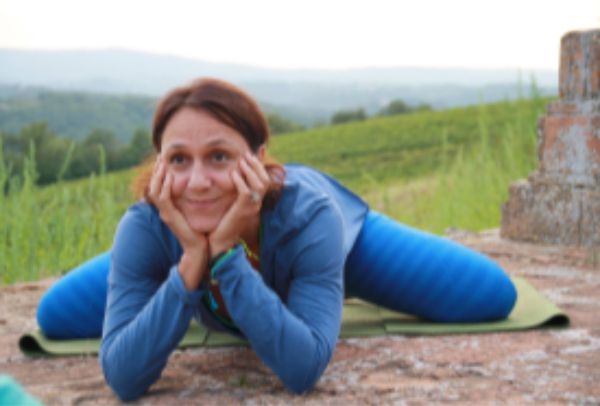1. WHAT MADE YOU STAND ON THE MAT FOR THE FIRST TIME?
I grew up in Brazil, meditating with angels in the presence of crystals. Already at the age of 14, I trembled during the dynamic Osho meditation and I was aware of what it gives me. During my PE studies in Brazil, I chose ashtanga as one of my subjects. This style of yoga was perfect for me, especially since I was also a swimmer and a triathlete. I fell in love with it!
2. DID YOU HAVE ANY HEALTH PROBLEMS THAT DROVE YOU INTO YOGA?
In my case yoga appeared very naturally. And it became the main tool to face life’s challenges and to focus on internal balance as well as being here and now.

3. WHAT IS THE CONCEPT OF YIN AND YANG YOGA, TAKING INTO ACCOUNT ALSO HATHA YOGA?
In comparison to Yang yoga, yin is a practice of much slower pace targeting the fascial tissues. Yang offers more rhythmical practice, which concentrates on muscles, but in case of Dynamic Yoga Spiral, also on the fascial tissue. Our body therefore works fascia in both the Yin and Yang yoga concepts. For a very long time the subject of the fascia was skipped. Now we know that it is the king of the tissues in our body.
4. WHAT IS FASCIA?
Fascia is a soft tissue component of the connective tissue system that extends across the entire body, starting from the head and ending at the toes. They surround the muscles, bones, organs, nerves and other structures of our body. Fascia is responsible for maintaining structural integrity and providing support and protection. In addition, it also acts as an absorber of shock that we experience. This is the most important tissue in our body – it is responsible for the transmission of energy, emotions and information.
5. HOW CAN YIN YOGA PRACTICE HELP US WORK ON TRAUMA?
Working with fascia often goes side by side with trauma. Trauma does not have to be huge. It is a more or less overwhelming problem or an event in our lives, which we haven’t had the chance to work on to restore our balance. The accumulated energy from trauma is stored in the nervous system and fascia tissues. Trauma tightens, blocks and paralyses the body. The practice of Yin fascia yoga helps the body to open up and gradually release accumulated tensions from trauma by staying longer in a position and knowingly maintaining it, even when not really comfortable emotions appear.
6. ARE THERE OTHER AFFLICTIONS AND CONDITIONS IN WHICH YIN YOGA CAN HELP?
Yin yoga can heal joints, those that result from fibromyalgia and the Costen’s syndrome and carpal tunnel syndrome, also with various body pains, as well as bring relief to the nervous system and greater awareness, sense of being grounded and satisfaction.
7. Yin yoga is for everyone who would like to experience all of its advantages for the body and spirit, which I’ve mentioned here.
Yin joga jest dla każdego, kto chciałby doświadczyć wszystkich jej zalet dla ciała i ducha, o których tutaj opowiadam.
8. HOW WOULD YOU, IN ONE SENTENCE, ENCOURAGE SOMEONE, WHO WOULD LIKE TO TRY YOGA, BUT IS AFRAID, DOESN’T KNOW IF THEY ARE READY FOR THIS FORM OF PRACTICE, OR THINKS THAT HE OR SHE IS NOT FIT ENOUGH?
SIMPLY TRY IT! You have nothing to lose, do not take it too seriously, laugh when you fail to keep your balance and fall.
9. DO YOU PRACTICE OTHER WAYS OF SELF-DEVELOPMENT WHICH HELP YOU WALK THROUGH LIFE?
Yes. It is singing mantras and insight meditation.
10. NOWADAYS YOGA IN POLAND IS DEVELOPING VERY FAST. DO YOU HAVE ANY TIPS FOR BEGINNERS?
Find an experienced and authentic teacher who will guide you. Try classes in different schools until you find one that you can identify with and stay there until you feel the benefits of the practice that yoga offers you. Be grateful for what you get in and out of the classroom.

